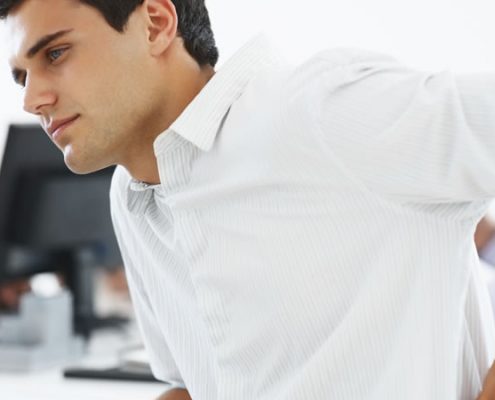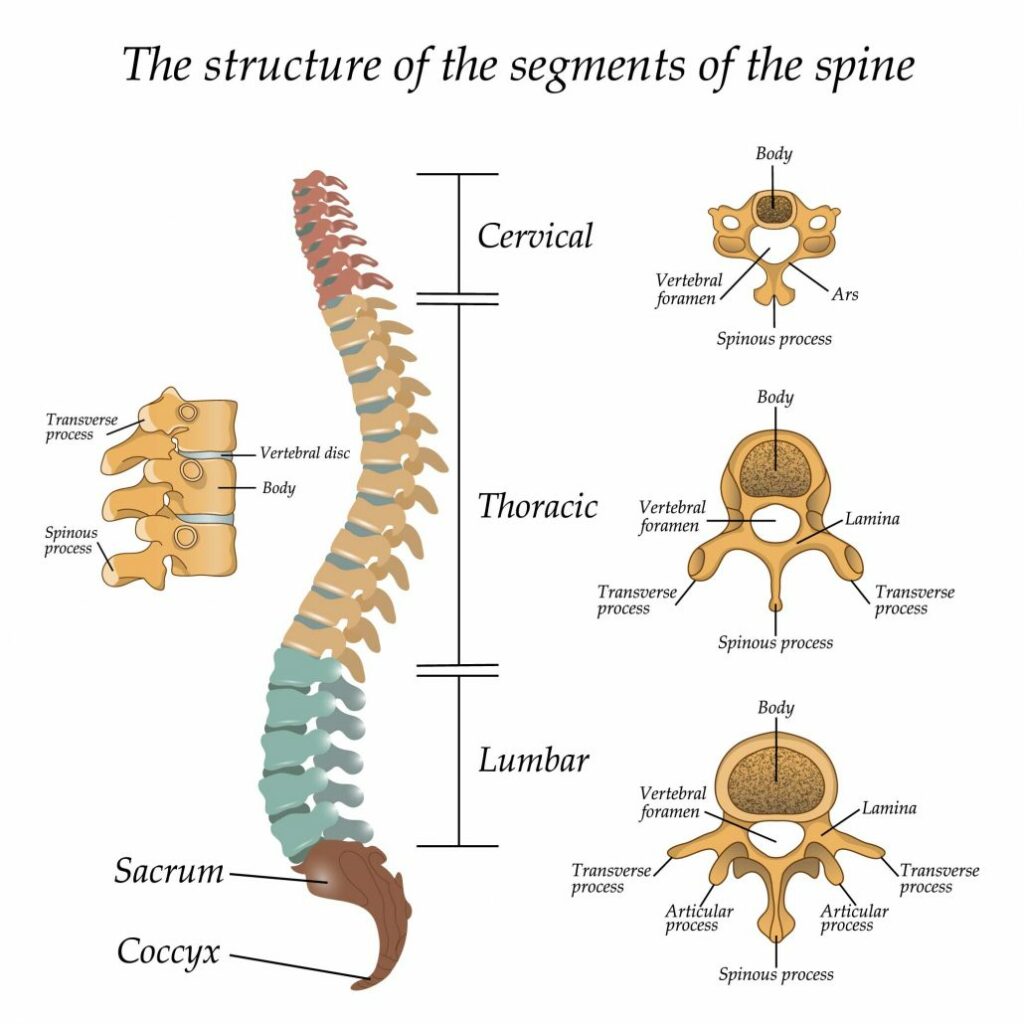Lower Back Pain – Symptoms, Treatment and Exercises – Part I
- February 26, 2023

Causes, Treatment And Exercises – Part I
by Phil Mack
Consultant Sports Physiotherapist
This is the first part of our two part series on lower back pain, its causes, treatments and exercises. Part 1 explains the structure of the back and the common causes of lower back pain.
In the second part we go on to discuss treatment and exercises to help relieve your lower back pain.
Lower Back Pain
Lower back pain is something most of us will experience at some stage during our lives and is the most common reason for missed days at work.
Back pain affects primarily the lower back and the good news is, that in most cases, the cause of pain is not serious and can be resolved in a few days or weeks. However, some symptoms can be more serious requiring a full assessment and diagnosis by an experienced Physiotherapist or GP. This article will help you to determine when self-help is enough or when it is best to seek further advice.
If you are experiencing lower back pain, our Physiotherapy and Occupational Health teams are here to help by providing comprehensive treatment and advice. On-site workplace or workstation assessments are also available which is the best starting point for back pain at work. For further information call 0131 218 3000 or email info@physioclinics.scot
Understanding Your Back
Your spine is made up 24 separate bones called vertebrae which are connected together by a series of ligaments and soft tissue. The lower part of your spine is joined to the sacrum which is part of your pelvis.
The curves, shapes and various sizes of the vertebrae (along with the discs found in between them), help to evenly distribute the weight of your body on the spine and creating the flexibility necessary to bend or rotate your back.
A complex group of muscles are attached to the spine which allows you to move your back. There are also postural muscles which help to maintain the shape and curves of your spine, keeping them in the correct position, as well as help to keep you upright.
The spinal cord passes through the centre of each vertebra. The cord ends in your lower back where it becomes a series of strands called the “cauda equina” (horses tail). Either side of each vertebra are spinal nerve exits from the spinal cord which pass sensory and motor signals between your brain and a certain part of your body which the nerve innervates.

What Causes Lower Back Pain?
The most common cause of back pain, especially lower back pain, is a combination of poor posture and lack of movement, typically seen with people who sit for long periods. This is known as mechanical back pain and is not a serious condition. However, it can be uncomfortable and frustrating to experience a constant ache or pain in your back.
Physiotherapy is ideal for treating mechanical back pain. Along with advice on correcting your posture, appropriate exercises and self-treatment techniques, your back pain should resolve in a few days or weeks.
However, there are more complex causes of back pain, for example, disc prolapse, joint impingement, ankylosing spondylitis, osteoporosis, arthritis or fracture which require a more detailed assessment.
Symptoms of Lower Back Pain
When you first start to develop postural back pain it manifests itself as a low-grade ache normally combined with stiffness in your lower back. Symptoms tend to be relieved with light exercise or by avoiding long periods of sitting, for example at weekends. But if symptoms are ignored, the pain will become constant, just to varying degrees. The level of stiffness may also increase.
Occasionally symptoms may be related to conditions other than poor posture, for example, prolapsed disc, fracture, facet joint impingement or nerve root compression. You may experience any of the following symptoms:
- Pins and needles or numbness in the buttocks, lower limbs or feet
- Pain going down the back or front of your leg
- More severe back pain, especially when bending forward
- Excessive levels of stiffness in your lower back
These symptoms need to be properly assessed by an experienced Physiotherapist. They will diagnose the cause of your lower back pain and provide appropriate treatment, management and advice.
A very small percentage of back pain can be caused by more serious conditions like cauda equina, where the nerves at the bottom of your spinal cord are being compressed. If you experience any of the following you should seek immediate medical advice:
- Unsteady when standing or walking
- Difficulties passing or controlling bladder or bowels or numbness in either area
- If you have a previous history of cancer or osteoporosis
- Back pain accompanied by unexplained weight loss or fever
Lower Back Pain and Poor Posture
Poor posture is normally the result of weak or imbalanced core muscles which help maintain the spine in the correct position – like guidelines of a tent. When these muscles are weak it is very difficult to keep your spine in the correct or neutral position, especially when sitting for long periods. Eventually, the soft tissue structures around the spine become overloaded, initially manifesting as a dull ache across your lower back, but if the overload is not reduced, eventually pain and stiffness will develop.
Other muscles may also be contributing to developing poor posture and back pain. For example, your main leg muscles (hamstrings and quadriceps) can become tight from inactivity, sitting or driving for long periods. As a result, the increased tension from either of these muscles can pull your pelvis out of position and increase the tension on your lower back. Then further sitting will exacerbate the overload to your lower back, resulting in pain.
Running and Lower Back Pain
Lower back pain which develops from running is normally due to poor running technique.
The most common running technique fault we see at our sports injury clinics is poor glute medius activation. This is one of the most important muscles for running as it helps to stabilise the pelvis which in turn helps to maintain the alignment of the spine. They also are important for maintaining healthy hips and knees.
Runners with poor glute medius activation tend to have a crouched style of running making it difficult to adopt a normal upright running technique. As a result, the lower back gets overworked which usually leads to pain.
This common running fault is easy to fix using one exercise, the lunge. When performed correctly, it will help you to engage your glute medius muscles at the right time. However, the exercise needs to be performed correctly and it may take a few weeks to feel and see the difference.
Your lower back pain when running may also be caused by poor posture due to weak core muscles. If you sit all day at work you may also develop stiffness in your lower back and leg muscles. This is where carrying out a proper warm-up prior to running is essential.
If you are not sure what is causing back pain when you run, an experienced Sports Physiotherapist will be able to help you work this out for you.
Cycling and Lower Back Pain
The cause of lower back pain whilst road cycling and mountain biking is generally caused by an incorrect bike position set-up. For example, the saddle to handlebar distance is too short or too long. Either can cause your lower back to overwork, just in different ways. The end result is the same, and back pain and stiffness may develop. If you are uncertain about your bike position and set-up, it is best to seek the advice of an experienced bike mechanic.
With mountain biking, riders often carry heavy rucksacks full of tools, extra clothing, water and food. This can place a direct load on the lower back making the soft tissue structures work even harder, especially with all the movement that occurs over rough terrain. Here is another article specific to back pain and mountain biking Back Pain and Mountain Biking.
Remember, your pain may not be actually from the bike and could stemming from your work or other activities away from the bike. So before rushing to change your bike set-up, make sure you figure out what is likely to be causing your lower back pain. If you are not sure, an experienced Sports Physiotherapist will be able to help you.
Does Stretching Help Reduce Lower Back Pain?
It is almost a daily occurrence to have a patient attend one of our clinics suffering from lower back pain, to explain they have, for example, been stretching their back every day for a month and it has made no difference to their back pain.
With typical posture related back pain, the soft tissue structures in the lower back are overloaded ie they have been at full stretch for hours on end until pain starts to develop. Therefore, it won’t be a surprise to know that further stretching is unlikely to help. What is required is gentle movement, not stretching (see exercises below).
However, stretching of other muscle groups like hamstrings, quadriceps and glutes can help to relieve the tension on the lower back muscles.
Further Advice for Lower Back Pain
If you require further advice and treatment for lower back pain, make an appointment with one of our experienced Physiotherapists or call us on 0131 218 3000 or email info@physioclinics.scot

Phil has over 17 years of experience working with professional and international athletes and teams throughout UK, Australia and South Africa, including the South African Springboks, Leicester Tigers and Ulster Rugby as well as the South African Triathlon Team.
Phil Mack